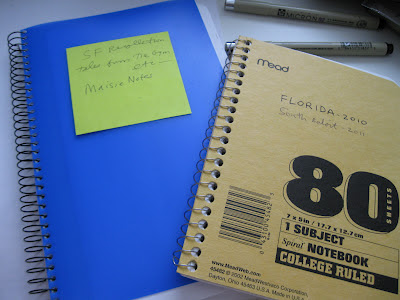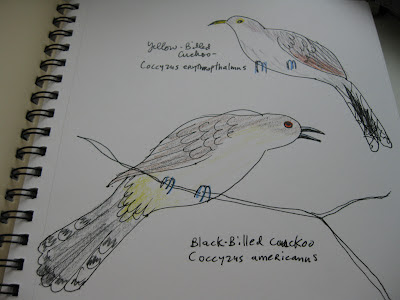I've written the last few times (Part One / Part Two) about the materials I use to make my comics. This time I'll talk a little bit about the process of putting them down onto paper.
PROCESS
Basically, I keep little notebooks around that I fill up with ideas: memories, turns of phrase, poems, lists,
dialogue, which at some point become my comics. Above are two recent examples. The Florida/South Beloit one has all my notes from the last three issues.
On the left, a list of stories, with page counts, for the latest issue, #73. On the right, a draft of the Snornose column. Oftentimes I'll pull images and lettering directly from my notebooks: That "Snornose '73" title lettering will be in the printed zine.
Here's another recent spread. On the left is a bit of graffiti I saw in a Toronto bathroom stall. I turned this into a comic for the new issue, but in the editing phase pulled it as it disrupted the general flow of the zine as a whole. Maybe it will will show up in a later issue, or in an anthology or something.
To the right is another, earlier, list of stories/pages for #73. A huge part of my process is editing stuff out. The Bridges of South Beloit was a story I worked on diligently for many months this summer, but again, it just didn't fit into #73. I plan to make this story the core of #74, though. Lists like these help me keep track of how close I am to having enough material for a new issue, and they're constantly being updated, edited, and reformulated.
Sometimes I just draw funny pictures.
This spread dates from King-Cat #72: A Snornose page (left) that was totally redone in the finished version, and the first page of the Batty Batty Batty story that closes the issue.
I almost always draw my comics from a well-considered script. The script usually contains just text-- descriptions, narration, and dialogue. Sometimes I'll throw in little drawings, but it's mostly just text. In the first draft I typically throw in everything that comes to mind, and the writing process for me is editing all that down into a more streamlined, rhythmic story. The vast majority of the time and energy I spend on an issue of King-Cat is on the writing part of it. Some stories come out just fine the first time around, but many need extensive revising and editing. The Perfect Example storyline, for instance, took ten years of work (off and on) before it felt ready for me to start drawing. That's an extreme example, but it just goes to show you, you can't force things. When it comes time to actually sit down and draw the comic it usually goes pretty quick, because the script is so precise.
Above two images: The rest of the Batty story, plus Snornose from #72.
It's very rare that I do thumbnails or things of that sort. I may occasionally do very small, rough ones, to help me gauge panels breakdowns, but usually I can "see" the pages/panels in my head before I draw them, and I just try to bring that out on the page when I start drawing. Above, the thumbnails for "At the Movies," which originally appeared in Roctober #50, and is being reprinted in the new King-Cat.
Pages from the script to "In Search of the Cuckoo Bird," from the new issue.
Once the script is complete, I begin drawing the actual comics pages. I draw first with a non-repro blue pencil, and ink over that. The penciled lettering is often pretty rough, and acts as more of a place-holder, as seen above. The drawings themselves though are pretty tight.
A big part of cartooning is fixing up your mistakes. When I'm inking, and I make a mistake, I usually note it immediately in the margin, so I remember to go back and clean it up. I'll also usually place a little mark on the drawing to help me remember where to clean things up. The dot in the drawing above means "clean up the inside of the word balloon."
When lettering this panel, I ended up with a hanging "I" and moved it to the start of the next line. The arrow and crossout will remind me to remove the extraneous "I" later.
Another stray line, marked for cleanup. The little tag makes sure I remember which line to white out.
A close-up on one of my fix-it jobs. When inking, I couldn't decide whether to cut the boot off at the panel-line, or have it break through, so I drew it both ways and decided later. Hence, the question mark in the margin.
Using tracing paper to re-letter a title. (The original inking bled badly on the paper.)
My margins are often fairly crooked. Sometimes I let them stand as is, but in really egregious examples I'll go back and redraw them. Here I've drawn the new panel line, and marked the old one for removal.
A page from my sketchbook. A portion of this drawing ended up being pasted into the "Cuckoo" story.
It used to be that the very first page I got done of a new King-Cat was the cover. I'd finish the previous issue and immediately draw the next cover. Nowadays it's usually the last thing I get done, and oftentimes the guts are complete for weeks while I struggle to come up with a suitable image. For #73, I knew I wanted a cuckoo on the cover, so this is just a sketchbook page where I started working the ideas out.
A more precise drawing I made for the cover design.
At some point it occurred to me that the drawing might look good in a woodcut style, so I went to Hobby Lobby and bought the supplies, and made my first linocut since high school.
Then, once the pages are all drawn, inked, and edited, I sit down and start scanning them into Photoshop. (I use Photoshop Elements, the mini-version of the program, which has always suited my needs just fine.) I'm pretty intimidated by technology, so I always dread this part. But I put my head down and do it. I use the guidelines offered in Jordan Crane's famous Reproguide: Scan in at 600 dpi grayscale, run the linework through the Threshold filter, convert to bitmap, and then save as a TIFF with LZW compression. (My printer uses 600 dpi files; for other work I sometimes upsize the grayscale files to 1200 dpi before running Threshold.)
I try my mightiest to have the pages completely done by hand BEFORE scanning, so that my Photoshop editing is kept to a minimum. But I still do plenty of cleaning up and fine-tuning digitally before saving the final files.
And here's the finished zine.

























Well! I enjoyed seeing the process. And the woodcut was nifty, too.
ReplyDeleteThis is really neat. I love your notations of dots and lettering. I never used the non repro bue pen. Sometimes I do not even use a pencil and I like just drawing pen to paper. I almost always draw that way for my Tofu Baby comics. I think it is just faster.
ReplyDeleteI also use Photoshop, but I scan at 600 dpi in color. I then convert to grayscale and adjust my lines with Curves, Brightness and Contrast, and Exposure. I do not use bitmap, as it made my lines look blocky!
Also - do you sit at a desk? I usually draw with a pillow on my lap in front of the tv. I love drawing in front of the tv.
ReplyDeleteI draw at a drawing table set to be flat, in the most awful hunched over, twisted manner, that I often have to take a day off after a day of drawing/inking to give my body a break...
ReplyDelete